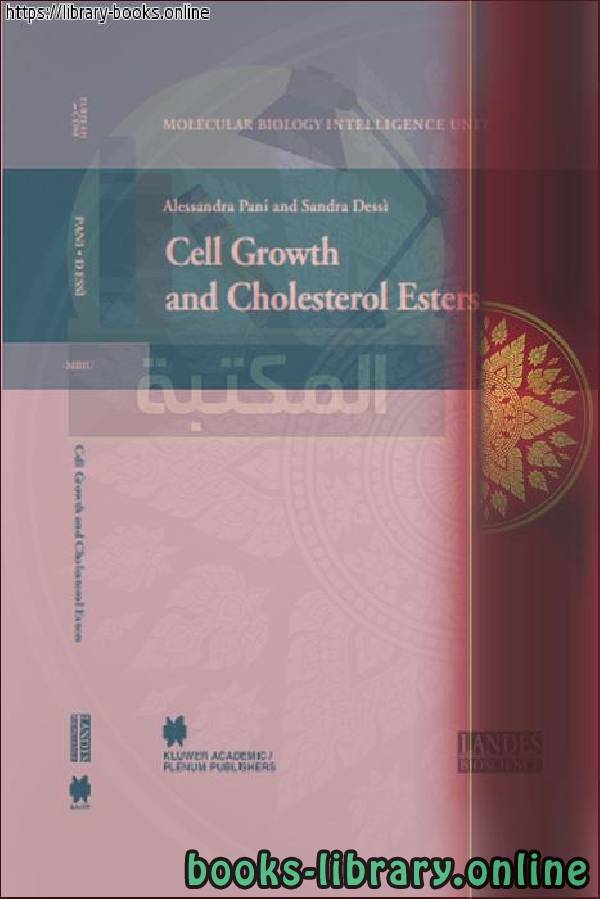📘 ❞ Molecular biology intelligence unit Sandra Dessi-Cell Growth and Cholesterol Esters ❝ كتاب ــ Alessandra Pani, Ph.D. اصدار 2005
Biology Books - 📖 كتاب ❞ Molecular biology intelligence unit Sandra Dessi-Cell Growth and Cholesterol Esters ❝ ــ Alessandra Pani, Ph.D. 📖
█ _ Alessandra Pani, Ph D 2005 حصريا كتاب ❞ Molecular biology intelligence unit Sandra Dessi Cell Growth and Cholesterol Esters ❝ 2025 Esters: نبذه عن الكتاب: Exogenous Uptake: The LDL Receptor Pathway Exogenous cholesterol is mainly obtained by the internalization of cholesteryl rich lipoproteins via receptor pathway 10 This known since 1973 its discovery led to award Nobel Prize to Brown Goldstein in 1985 It well that a hydrophobic molecule quite insoluble water Thus, it cannot pass from liver or intestine cells simply dissolved blood in extracellular fluid Instead it carried tiny droplets lipoprotein most abundant cholesterol carriers human are LDLs LDL particles spheres with core containing esters covered a single layer phospholipid molecules their hydrophilic heads exposed watery fluid (e g , blood) tails directed into interior Over thousand molecules of bound A protein, called apolipoprotein B 100 (ApoB 100) at surface each particle first step in acquiring binding receptors localized cell pits coated clathrin, protein involved formation transport vesicles from membranes glycoprotein molecular weight 164 kDa having site recognizes binds ApoB on Once LDL binds receptor, ligand collected pits, internalized form coated clathrin coat then removed uncoated vesicle fuses endosomes to form an early sorting endosome Here, ATP dependent proton pumps lower pH which causes separate Biology Books مجاناً PDF اونلاين Biologically Biology natural science concerned study life, various forms function, how these organisms interact other surrounding environment word Greek made up two words: bio (βίος) meaning life And loggia ( λογία) means Biology: similarity vegetation animal cover edges African American states, existence same fossil Branches biology Biology ancient thousands years old modern began nineteenth century has multiple branches Among them are: Anatomy Botany Biochemia Biogeography Biofisia Cytology science Ecology environmental science Development Embryology embryology Genetics genetics Histology histology Anthropology anthropology Microbiology bacteriology Molecular Biology Physiology functions organs Taxonemia taxonomy Virology virology Zoology zoology

كتاب
Molecular biology intelligence unit Sandra Dessi-Cell Growth and Cholesterol Esters
ــ Alessandra Pani, Ph.D.
صدر 2005م
كتاب
Molecular biology intelligence unit Sandra Dessi-Cell Growth and Cholesterol Esters
ــ Alessandra Pani, Ph.D.
صدر 2005م
نبذه عن الكتاب:
Exogenous Uptake: The LDL Receptor Pathway
Exogenous cholesterol is mainly obtained by the internalization of cholesteryl-rich lipoproteins via LDL receptor pathway.10 This pathway is known since 1973 and its discovery led
to the award of the Nobel Prize to Brown and Goldstein in 1985.
It is well known that cholesterol is a hydrophobic molecule quite insoluble in water. Thus,
it cannot pass from the liver and/or the intestine to the cells simply dissolved in blood and in
extracellular fluid. Instead it is carried in tiny droplets of lipoprotein. The most abundant
cholesterol carriers in human are the LDLs.
LDL particles are spheres with a core containing mainly cholesterol esters covered with a
single layer of phospholipid molecules with their hydrophilic heads exposed to the watery fluid
(e.g., blood) and their hydrophobic tails directed into the interior. Over a thousand molecules
of cholesterol are bound to the hydrophobic interior of LDL particles. A protein, called
apolipoprotein B-100 (ApoB-100) is exposed at the surface of each LDL particle. The first step
in acquiring LDL particles is their binding to LDL receptors that are localized at the cell surface in pits coated with clathrin, a protein involved in the formation of transport vesicles from
membranes. LDL receptor is a cell surface glycoprotein with a molecular weight of 164 kDa
having a site that recognizes and binds to the ApoB-100 on the surface of the LDL. Once LDL
binds the receptor, ligand and receptor are collected in the coated pits, and internalized to form
coated vesicles. The clathrin coat is then removed and the uncoated vesicle fuses with endosomes
to form an early sorting endosome. Here, ATP-dependent proton pumps lower the pH which
causes the LDL to separate from its receptor.
#843
0 مشاهدة هذا اليوم#49K
4 مشاهدة هذا الشهر#73K
4K إجمالي المشاهدات- 🎁 كن أول كاتب اقتباس في هذه الصفحة واحصل على هديّة 15 من النقاط فوراً 🎁
